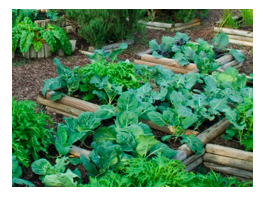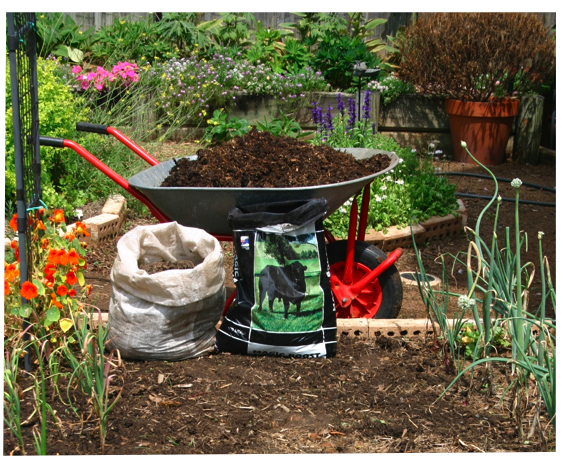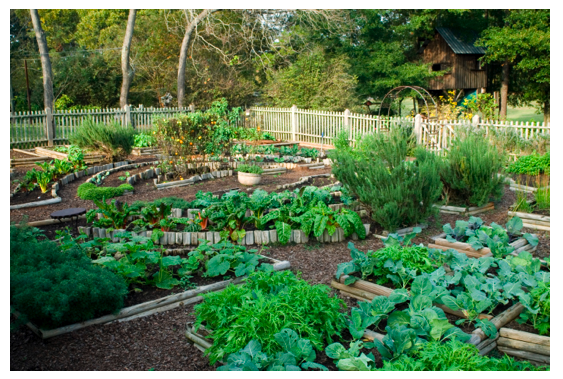 I’m often asked about the best way to set up a new vegetable garden, and everyone seems to have their preferred method and materials. I personally, like the idea of a no dig garden bed. After all, who wants to break their back trying to dig up hard compacted clay soil? No dig garden beds are easy, quick and effective in providing vegetables with all the nutrients they need.
I’m often asked about the best way to set up a new vegetable garden, and everyone seems to have their preferred method and materials. I personally, like the idea of a no dig garden bed. After all, who wants to break their back trying to dig up hard compacted clay soil? No dig garden beds are easy, quick and effective in providing vegetables with all the nutrients they need.
Vegetables are incredibly hungry and thirsty plants, since they are growing quickly and developing fruit in a short period of time, they need loads of food to get them to maturity …. rather like some of the teenagers in my house! So a no dig garden bed is just perfect for them (the veggies, not the teenagers). So here’s my step by step approach to no dig raised vegetable gardens.
Location, location, location
To start with you’ll need to find a sunny spot to locate your vegetable garden. A garden in the shade will not be as productive as one that gets adequate sunlight. Try to find an area that gets at least 6 hours of sunlight (some dappled light is okay and can even help give respite to plants in the middle of our hot summers). Plants need sunlight to produce a flower so any vegetable that is grown for it’s fruit will certainly need this amount of sun.
Vegetable plants grown for their leaves or stems will tolerate less sun and we actually want to discourage these plants from flowering. Lettuces, silverbeet, celery and Asian greens are more particular about the amount of water they receive than sunlight. So if your proposed vegetable patch receives less than the desired 6 hours of sun, then stick to these leafy crops for better results.
If it’s a brand new area you’ve chosen then you don’t even need to dig up any grass, you can simply mow the grass and/or weeds down to the lowest setting to make the area easier to work on.
Step 1 – newspaper
Our first step is to lay out sheets of overlapping newspaper directly on the ground. This kills off any weeds and grass naturally and allows them to decompose into nutrients for the soil later. Just make sure to use about 10 sheets of newspaper together to get the right thickness and overlap the sheets by about 10cm on all sides. Keep the newspaper damp with water from the hose after you lay it down. I often work with a wheel barrow full of water and dip the sheets of paper in as I go. This stops any wind blowing them all over the yard!
Step 2 – lucerne hay
This is a nitrogen rich layer of lucerne hay. A large bail will cover a good sized vegetable garden bed. Take off “biscuits” or sections of the lucerne and lay them over the newspaper to cover the whole area. You will need this to be about 5 to 10cm thick.

Step 3 – compost & manure
Lay about one wheelbarrow full of compost and a couple of 25 litre bags of manure on top of the lucerne. Spread this over to give a complete cover. If you have been making your own compost then this would be perfect. Mix in a combination of chicken manure and cow manure to give some added nutrients. Throw over a couple of handfuls of rock dust and dolomite lime. Again, make sure to water this in before proceeding.
Step 4 – sugar cane
The next layer is a carbon rich mulching layer. Use straw or sugar cane for this, to a depth of about 5cm.
Repeat
Now just repeat step 2 to step 4 over again until you reach your desired height. The higher your bed is, the better drainage it will have and less bending you will need to do. Always end with a layer of mulch and water it in each layer with a hose as you go.
Leave your garden bed to rest for a couple of weeks before planting. This allows for it to settle first and it will drop in size to about 1/2 the original height.
Planting
When you plant into the no dig vegetable garden, just make a hole in the mulch layer and drop in a seedling. Backfill the hole with some potting mix or compost and firm down the seedling to hold it in place. Give it some water and diluted seaweed solution and then sit back and watch it grow.
Try to avoid any root crops like carrots or beetroot or onions for the first year. Your bed will have too many nutrients and will encourage leaf growth at the expense of root development. Grow a few crops through the bed first to soak up excess nitrogen and then after a year try some root vegetables. Make sure you plant according to your climate and season for best results. After a year the material used in your raised vegetable garden will have composted down so they look like beautiful friable garden soil.

Materials needed for a no dig garden bed measuring 1 x 2m:
Newspapers to cover an area of 2 square metres
1 large bail of lucerne
1 wheel barrow of compost
2 x 25ltr bags of manure (chicken/cow combination)
2 handfuls of rockdust
1 small handful of agricultural lime or dolomite
1 bail of straw or sugar cane mulch
seedlings
seaweed solution
For more information and videos on preparing a vegetable garden see Toni’s online Backyard Veggies course




 Twitter
Twitter Facebook
Facebook
Is it necessary to top up the layers after the first year? Can potatoes be grown in the first year?
Regards,
Evelyn
Potatoes are a great choice for first year. And yes you will need to tope up the layers after about 12 months.
I have prepared the raised garden as recommended. Can you advise why the soil under the sugar cane mulch is now so hot? Is this a problem? If so what should I do?
This is totally normal. The bed reacts almost like a compost heap and heats up during the first week or so as the microbes do their job of breaking down materials. It’s actually a good sign and you might even get some little mushroom like fungus appearing also. Again this is normal. This is why it’s best to wait a couple of weeks before planting. Your efforts will soon be rewarded.
Once I have completed your raised garden bed, am I to water it daily for the first couple of weeks before I start planting?
Cheers. Mal
No you shouldn’t need to water it that often. Check it and see if it needs any water first. The materials used will retail a fair amount of moisture anyway.
Cheers, thank you.